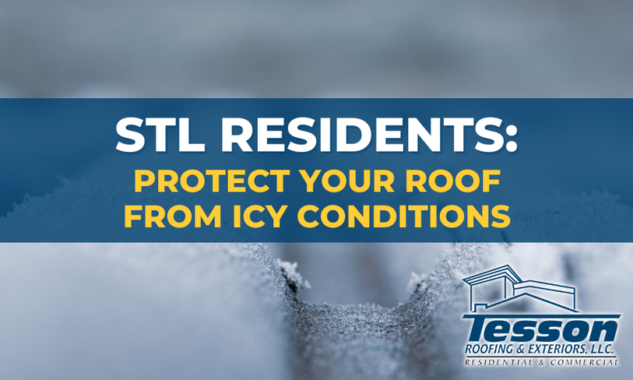Ice dams, those stubborn ridges of ice that form near the eaves of a roof, can wreak havoc on your home if left unchecked. At Tesson Roofing, we’re here to shed light on what causes ice dams, why they’re problematic, and the best ways to prevent and deal with them. Here’s how locals are preventing ice damage:
What are Ice Dams?
Ice dams are formed when melted snow on the roof refreezes near the eaves, creating ice ridges that trap water behind them. This trapped water works its way up toward the roof ridge, posing a risk of damage to your roofing structure.
Causes of Ice Dams: The Melt-Freeze Cycle
The formation of ice dams is part of a melt-freeze cycle that typically unfolds over several days:
- Snow Melting:
- Heavy snow on the roof melts during warmer periods, usually in daylight.
- Water Collection:
- Water collects on the roof eaves, near the gutters.
- Freezing:
- When temperatures drop again below freezing, the collected water turns into ice.
- Ice Buildup:
- Subsequent melt-freeze cycles cause the ice to build higher, forming dams.
- Water Trapping:
- Water eventually becomes trapped behind the ice dams.
Why Are Ice Dams Problematic?
Ice dams pose a serious threat because they trap water, which can find its way under the shingles. As snow on the roof melts, the water is unable to reach the gutters due to the presence of ice dams. This trapped water then penetrates the roofing structure, leading to leaks through the ceiling and into the home.
Preventing Ice Dams: Tips from Tesson Roofing
- Clean the Gutters:
- Regularly clean the gutters between fall and winter to ensure proper snowmelt flow away from the house, preventing it from reaching the shingles.
- Roof Raking:
- Use a long-handled roof rake to remove excess snow from the roof, reducing the potential for ice dam formation.
- Insulation Upgrade:
- Add R-30 attic insulation or upgrade existing insulation to R-30, or R-38 in extremely cold climates.
- Soffit Vents Installation:
- Install vents in the soffits to promote airflow and prevent ice dams.
- Roof Ice-Melting Cables:
- Consider installing electric ice-melting cables on the eaves to melt ice and allow water to flow to the gutters.
Dealing with Existing Ice Dams: Steps to Take
- Roof Raking:
- Rake the roof from top to bottom with a roof rake to remove snow and loosen areas of ice.
- Use Ice Melt:
- Place calcium chloride in socks or pantyhose along the roof to melt the ice.
- Hose with Tap Water:
- Run hose water over the ice dam on a warm day to facilitate melting.
- Use Warm Water:
- Direct warm water over select sections of the ice dam using a lawn sprayer or watering can.
- Break Dams with a Mallet:
- Safely use a rubber mallet to break out sections of ice along the roof edge.
When to Seek Professional Help
If dealing with severe ice dams, it’s wise to call in professionals for snow removal, with an average cost of $1,200. While it may seem like an investment, it pales in comparison to potential expenses for repairing roof, insulation, ceiling, or wall damage.
At Tesson Roofing, we prioritize the well-being of your home. If you’re grappling with ice dams or need assistance with preventive measures, contact us today. Our experts are ready to ensure your roof stays secure and your home protected. Contact us here or call (314) 932-1042.
